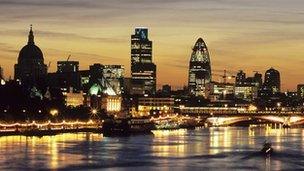The elusive truth about Barclays’ lie
- Published
- comments

How many liars are there in the City of London?
Aside from the forensic analysis about who said what to whom, there is a very simple question at the heart of the furore of Barclays' involvement in the LIBOR-rigging scandal: is it ever acceptable to lie?
At the height of the banking crisis in 2007 to 2008, I as an enquiring journalist was routinely lied to by bankers: they claimed they were able to borrow from conventional sources relatively easily and were not on the brink of financial collapse. In the case of HBOS and Royal Bank of Scotland, we subsequently learned this was untrue; in the autumn of 2008, they became dependent on massive emergency loans from the Bank of England, which led directly to them being partly nationalised.
There was an appalling climate of fear, in which no bank felt completely confident of survival.
Now in this climate, Barclays was among the least trusted of the banks. Investors, for years, feared they didn't properly understand how its complex investment bank earned its profits. Ministers and officials felt it was arrogant and opaque as an institution.
I know this because it was one of the big talking points in my milieu.
It was this lack of trust which meant that Barclays had to pay more to borrow than other banks: for any creditor, trust in the borrower is probably more important than anything else; and any uneasiness about the strength of the debtor translates into the debtor paying a higher interest rate.
Barclays ex-boss Bob Diamond is 'sorry and angry'
Now I recall talking about the relatively high rate Barclays was paying to borrow to people in government and Whitehall. It was both intriguing and disturbing to them.
As it happens, Bob Diamond's note of his conversation on October 29 2008 with Paul Tucker, deputy governor of the Bank of England, implies he was having similar conversations with the ministers and officials of SW1.
Many would say that the proper lesson for Barclays from these funding tensions was that it needed to regain the trust of the market - by perhaps simplifying its operations and making them more transparent.
What we learned from the regulators' verdict on Barclays last week was that in fact its response was to lie about its borrowing costs: it understated them to try to reassure the market.
Barclays' defence is that it was dreadfully unfair that its perceived borrowing costs were higher than other banks. And it is convinced that many of these banks were even bigger liars than it was about what they were paying to borrow.
It also points out that in practice its balance sheet, its finances, were in fact stronger than many of these other banks: its creditors were wrong, it would say, to have so little trust in it.
So was its lie about what it was paying to borrow justified - especially if the survival of the bank was at stake? And if Paul Tucker at the Bank of England encouraged Barclays to lie, as is implied by Diamond's memo, would he have been justified in doing so?
As it happens, a number of senior figures in the City who are unconnected to Barclays think this lying was the right thing to do in the circumstances. They think Mr Tucker encouraged Barclays to lie and they applaud him for doing so.
You might well say that is evidence of a cancerous moral relativism at the heart of the City. Or you might applaud their common sense realism.
We need Paul Tucker's side of the story to evaluate whether he did indeed nudge Mr Diamond to a policy of economy with the truth on the bank's borrowing costs - and, if he did so, whether he was responding to pressure from what Mr Diamond calls "senior figures in Whitehall".
But here's a question for you: was Barclays making a small lie for a bigger purpose; or was its instinct to lie at the very heart of the problem, the reason why it was so little trusted in markets and was having to pay more than others to borrow?